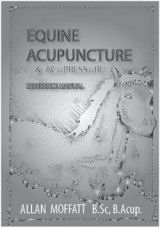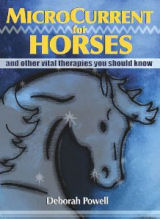Acupuncture & TCM Articles

Allan Moffatt B.Sc., B.Acup.
Equine Horse Acupuncture Articles
Allan Moffatt has trained as a human acupuncturist. He has been practising equine acupuncture with traditional Chinese methods for more than twenty years and has a good understanding of the underlying processes involved. He teaches these via his online courses. He is the author of Equine Acupuncture And Acupressure Reference Manual.
Allan has experience with all types of horses. Extensive experience with natural treatments including herbal medicine, flower essences, kinesiology and homeopathics.
For more information about Equine Acupuncture And Acupressure Reference Manual and seminars by Allan Moffatt, please visit his website at www.horse-acupuncture.com
Equine Horse Acupuncture and Acupressure Reference Manual
PREFACE
The approach I have taken here is, to provide a helpful reference for both the professional such as veterinarians, and the beginner, in the Traditional Chinese Medicine approach to the healing of the horse.
The anatomic point locations are in veterinarian terms mostly and the photos are a useful adjunct to this for non-veterinarians. The Action of the points is described in the traditional Chinese approach to help to provide a bridge for the understanding of that approach and how it provides a real foundation for how acupuncture works, as against the chemical, biological approach of Western Medicine.
In my 20 years as an equine acupuncturist, I have always marvelled at how quickly horses respond to acupuncture without me trying to convince them. They do not need to have a big story told to them. They know it is helping and they are grateful.
I received my Bachelor of Acupuncture degree in 1980 from Acupuncture Colleges Australia located in Sydney Australia and in 1986 began applying what I had learned that had worked with people to the treatment of horses. Acupuncture is not just a matter of putting some needles in somewhere. There is a Science to it and an Art, and it is a complete system. Accuracy in the Yin and the Yang is paramount, and requires a deep appreciation of the Life Force, how it flows, how it operates, and how it sustains the livingness of the Being. This cannot be dispensed with, and must be accepted, and then Life can be understood.
The Indications is to give an idea of possible uses for the points. This is not meant to provide formulas or recipes for treatment after a Western diagnosis but to give an idea of the Western symptoms and how they relate to the Sphere of Action (of the points), the pathway of the channels and the Correspondences.
Lastly I have allowed in Innervations, i.e. Nerve connections. The nerves can be affected in acupuncture but it would be not helpful for me to even suggest that this is how it works. Actually it would be dangerous. The methods of needle manipulation are for working with Life-Force, not nerves. The later may cause damage and is to be avoided.
I have given the Chinese name of the points and their translations for a reason. Just in their names, they give a very good idea of, either the function of the points or the nature of their location e.g. Branch Ditch: looks, when touched, just like a ditch, and one can feel its connections to other places, so Branch.
There are many non-meridian points not listed here. After more than 25 years as a fully trained acupuncturist I am able locate and discern a point by feel, and also to know the nature of that point and its sphere of Action. This you may also learn.
Also I would like to acknowledge all those great masters who came before, whose knowledge has contributed to the Body of Knowledge which is Acupuncture today. I would have liked to have known them.
Allan Moffatt B. Sc. B. Acup.
 Equine Horse Acupuncture and Acupressure Reference Manual Equine Horse Acupuncture and Acupressure Reference Manual
Visit www.horse-acupuncture.com for order information
The approach I have taken here is, to provide a helpful reference for both the professional such as veterinarians, and the beginner, in the Traditional Chinese Medicine approach to the healing of the horse.
The anatomic point locations are in veterinarian terms mostly and the photos are a useful adjunct to this for non-veterinarians.
The Action of the points is described in the traditional Chinese approach to help to provide a bridge for the understanding of that approach and how it provides a real foundation for how acupuncture works, as against the chemical, biological approach of Western Medicine.
 MicroCurrent for Horses MicroCurrent for Horses
(and other vital therapies you should know)

MicroCurrent for Horses (and other vital therapies you should know) is reference book for professionals and horse owners interested in microcurrent therapy. It explores the past and present methods of this amazing therapy as well as many other complimentary therapies. With the addition of the many other therapies you can dramatically improve your results. This book is a real how-to book that reveals what many have paid thousands to learn in courses. The users of this knowledge will be empowered to tackle horse lameness issues with confidence. The reader will learn how to be more proactive in the care of their horses, saving money and down time. Expensive treatments such as shock-wave, joint injections, and surgery may not be the only option. Everyday new users discover how helpful these methods are for tendon, ligaments, hoof problems, body soreness and much more. There are simply too many barns with unsound horses that need not be. Examples of other animals including dogs, cats, and goats benefit from these therapies as well.
| 